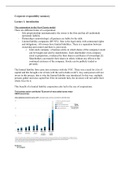Resume
Summary of Corporate Responsibility and Sustainability course with papers information and lecture notes
- Cours
- Établissement
This is a summary of the course corporate responsibility and sustainability . It includes lecture slides, notes and information from the papers
[Montrer plus]



